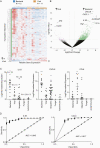Metagenomic Next-Generation Sequencing for Pathogen Detection and Transcriptomic Analysis in Pediatric Central Nervous System Infections
- PMID: 34104666
- PMCID: PMC8180245
- DOI: 10.1093/ofid/ofab104
Metagenomic Next-Generation Sequencing for Pathogen Detection and Transcriptomic Analysis in Pediatric Central Nervous System Infections
Abstract
Background: Pediatric central nervous system (CNS) infections are potentially life-threatening and may incur significant morbidity. Identifying a pathogen is important, both in terms of guiding therapeutic management and in characterizing prognosis. Usual care testing by culture and polymerase chain reaction is often unable to identify a pathogen. We examined the systematic application of metagenomic next-generation sequencing (mNGS) for detecting organisms and transcriptomic analysis of cerebrospinal fluid (CSF) in children with central nervous system (CNS) infections.
Methods: We conducted a prospective multisite study that aimed to enroll all children with a CSF pleocytosis and suspected CNS infection admitted to 1 of 3 tertiary pediatric hospitals during the study timeframe. After usual care testing had been performed, the remaining CSF was sent for mNGS and transcriptomic analysis.
Results: We screened 221 and enrolled 70 subjects over a 12-month recruitment period. A putative organism was isolated from CSF in 25 (35.7%) subjects by any diagnostic modality. Metagenomic next-generation sequencing of the CSF samples identified a pathogen in 20 (28.6%) subjects, which were also all identified by usual care testing. The median time to result was 38 hours.
Conclusions: Metagenomic sequencing of CSF has the potential to rapidly identify pathogens in children with CNS infections.
Keywords: encephalitis; meningitis; metagenomics; next-generation sequencing; pediatric.
© The Author(s) 2021. Published by Oxford University Press on behalf of Infectious Diseases Society of America.
Figures

References
-
- Okike IO, Ladhani SN, Johnson AP, et al. ; neoMen Study Group . Clinical characteristics and risk factors for poor outcome in infants less than 90 days of age with bacterial meningitis in the United Kingdom and Ireland. Pediatr Infect Dis J 2018; 37:837–43. - PubMed
-
- Tunkel AR, Hartman BJ, Kaplan SL, et al. . Practice guidelines for the management of bacterial meningitis. Clin Infect Dis 2004; 39:1267–84. - PubMed
-
- Britton PN, Dale RC, Blyth CC, et al. . Causes and clinical features of childhood encephalitis: a multicenter, prospective cohort study. Clin Infect Dis 2020; 70:2517–26. - PubMed
-
- Tunkel AR, Glaser CA, Bloch KC, et al. ; Infectious Diseases Society of America . The management of encephalitis: clinical practice guidelines by the Infectious Diseases Society of America. Clin Infect Dis 2008; 47:303–27. - PubMed
-
- Erickson TA, Muscal E, Munoz FM, et al. . Infectious and autoimmune causes of encephalitis in children. Pediatrics 2020; 145:e20192543. - PubMed

